Electrical safety posters: types of plates and graphic signs + application
Working with electrical installations requires responsibility, increased attention, and compliance with certain rules set out in regulatory documentation.Separate paragraphs are devoted to protective equipment, including electrical safety posters. What are they, what categories are they divided into and what are they intended for?
You will learn everything about posters that prescribe and prohibit activities during equipment repairs or electrical installations from our proposed article. We will tell you what types of posters are divided into and what shape they have. We list and describe the main and additional types of visual warnings.
The content of the article:
Posters as means of protection
Brightly colored images with explanatory inscriptions or symbols are called posters or safety signs. They have a certain geometric shape: rectangular, triangular, square.
Posters are needed to warn both workers and bystanders about the potential hazards posed by electrical installation equipment. Some posters directly prohibit performing certain actions, others carry an informational load, others allow and order work.
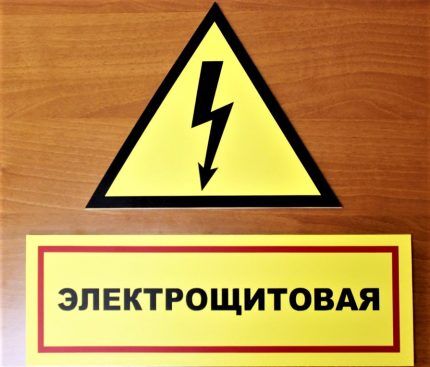
The document applies to any means of protection used by organizations of various forms of ownership - both state enterprises and private property, especially if the voltage in electrical installations is above 1000 V.

Workers involved in work in electrical installations must be provided with protective equipment, including posters, and explained how and where they should be used in order to ensure the safest possible working conditions. Portable signs must be part of the inventory that field teams are armed with.

Posters and signs are made in accordance with GOST. Unlike tools and clothing, they do not require markings and do not need to be numbered or otherwise marked.
Groups of electrical safety posters
There are 13 posters and signs in total. According to the instructions, according to their intended purpose, they are divided into 4 types:
- prohibiting – to prohibit switching devices from turning on/off in order to eliminate the risk of supplying voltage to the work area;
- warning – to warn workers that live parts are nearby and protective equipment is required;
- prescriptive – for permission to work, but taking into account compliance with safety requirements;
- index fingers – to indicate places where devices or objects are located (in particular those related to grounding).
The second group is the largest. It includes 4 posters and 2 signs. There are no signs in other categories.
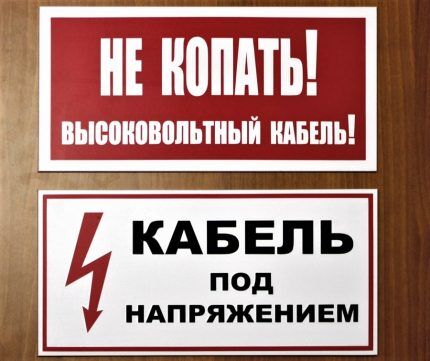
Based on the nature of their use, posters are divided into 2 groups:
- permanent (this also includes signs);
- portable.
All types of posters are made exclusively from electrical insulating materials, but permanent signs can be applied with spray paint or a brush to metal and concrete surfaces - walls, parts of structures. Metal parts with marked marks must be kept away from live circuits and devices.
And now in more detail about the types of electrical safety posters.
Group #1 – prohibiting
The category includes four signs, united by the same purpose, rectangular shape and the use of a red and white color scheme.
DO NOT TURN ON people working
A rectangular portable poster, which is used at construction sites and at electrical installation sites (up to 1000 V and above) in order to protect the workplace from voltage supply.
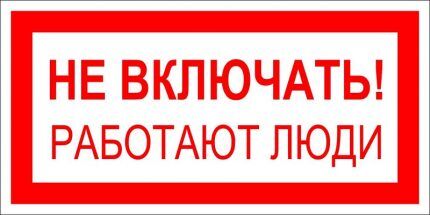
Installation locations:
- wires of switches and disconnectors;
- switches and machine guns up to 1000 V;
- remote control control buttons.
If a circuit with voltages up to 1000 V does not include switching devices, remove the fuses before starting work, and hang a poster near their installation site.
DO NOT TURN ON line work
A portable poster similar in design informs that people are working on the line, so supplying voltage is prohibited.

The purpose is the same as the first poster in the group - prohibition of actions with switching devices: buttons and switch levers, drives that supply voltage to the power cable with which installers work.
DO NOT OPEN people are working
A poster announcing the prohibition of actions that result in the supply of gas or compressed air.
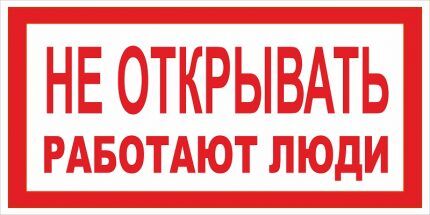
The poster is used at power plants and substations, in areas where electrical installations are located, so that gas or compressed air is not accidentally supplied to people performing electrical installation or repair work.
Installation locations:
- air duct valves;
- pipeline valves.
If you operate a switch or disconnector, move a valve or turn a valve, compressed air or gas (carbon dioxide, hydrogen, etc.) can cause harm to the health of electricians.
OPERATION UNDER VOLTAGE Do not switch on again
A portable poster prohibiting reactivation. Relevant for high-voltage line switches operating in automatic mode. If the line is automatically disconnected differential device or RCD, switching on can only be done after agreement with the service personnel.

The poster is hung on the control levers of the high-voltage line during repair work that involves supplying voltage.
Group #2 – warning
The group includes four posters in a red and white color scheme and two triangular signs with the image of a lightning bolt (arrow).
CAUTION ELECTRICAL VOLTAGE
A bright yellow sign warns that an electrical hazard exists and is posted or painted where live lines and devices are installed.

This is a permanent sign that can most often be found at substations and power plants.
Installation locations:
- entrance doors of control chambers, transformers and switch chambers;
- doors of electrical panels with voltage up to 1000 V;
- fencing structures of industrial premises, workshops of enterprises, repair areas.
For populated areas - villages, towns, cities, ports, agricultural enterprises, railway stations, beaches, etc., the same version of the sign is used.
The sign is mounted on metal or wooden supports of high-voltage lines at a height of 2.5-3 m from the ground surface. If the distance between the supports is more than 100 m, as well as when crossing the road, the sign must hang on each support. If the spans are less than 100 m, then it is hung not on each support, but through one.
CAUTION ELECTRICAL VOLTAGE
Like the previous sign, it warns of the risk of electric shock. The design is the same, but the background color is different.

A permanent sign designed specifically for placement on reinforced concrete supports and concrete fences of outdoor switchgear.
STOP voltage
A portable rectangular poster warning of the dangers of electric shock.

The poster is intended for use in substations and power plants.
Installation locations:
- temporary fencing for live devices and lines;
- barriers placed in aisles;
- permanent fencing of cells adjacent to the working area.
In switchgears located on the street, the poster is hung on cords that serve as fencing, as well as on structures made of wood, concrete or metal located close to live lines.
TEST is life threatening
A portable poster used during test work - when high voltage is applied and there is a threat to health.
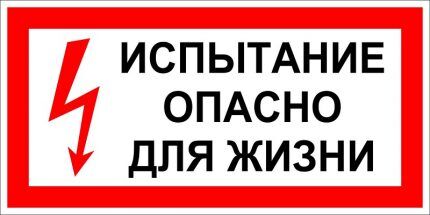
The poster is hung before carrying out work on testing high voltage lines. It is mounted on equipment or enclosing structures with the inscription facing outwards.
Danger! Keep out
A portable poster that warns of the risk of electric shock when climbing on structures or devices.

Usually the poster is hung not on a structure with a staircase leading to a workplace located at a height, but on an adjacent one.
DANGEROUS ELECTRIC FIELD without protective equipment, passage is prohibited
The poster is permanent and prohibits staying near the electric field without protective equipment. If this requirement is not followed, there is a risk of electric shock.

The poster is intended for outdoor electrical devices with voltages above 330 kV.
Installation locations:
- routes along which distribution devices are bypassed;
- workplaces located near an electric field.
A prohibitory poster is hung at a height of 1.5-2 m either on a fence or on a specially installed pole.
Group #3 – prescriptive
Signs in this group do not prohibit or warn, but serve to indicate places of work. They are distinguished by their square shape and blue and white color scheme.
WORK here
The prescription is obvious - a specific place for the repair team or maintenance personnel to work is indicated.

A portable poster is hung at substations and power plants to indicate workplaces. If the switchgear is located on the street, the best installation location is in the area of passage behind the fence.
CLIMB HERE
The regulation defines where you need to climb to a high-lying workplace to avoid danger.

Installation sites are stationary ladders or other structures specially designated for safe ascent to the workplace.
Group #4 – index
In this group there is only one portable poster indicating the prohibition of supplying electric current to a separate grounded section of the device or electrical installation.
GROUNDED
The poster is relevant for power plants or substations; it is mounted on switches, drives and remote keys that regulate the supply of electricity to grounded areas.

In addition to standard posters, it is allowed to hang larger ones if the equipment in electrical installations is large in size. The dimensions are regulated by the same GOST R 12.4.026.
Other posters and signs
In addition to the protective equipment from regulatory documents that are mandatory for use, there are a number of “amateur” type signs and posters. They are not mandatory, but are used to prohibit or permit certain actions with electrical equipment.
Some of them are informational and report on the technical characteristics of a line or electrical installation.

Others are variations of statutory posters and contain a prohibition or warning.
Some posters can be classified as educational. They are hung not in workplaces associated with danger, but in utility rooms, classrooms, offices - as additional educational material.
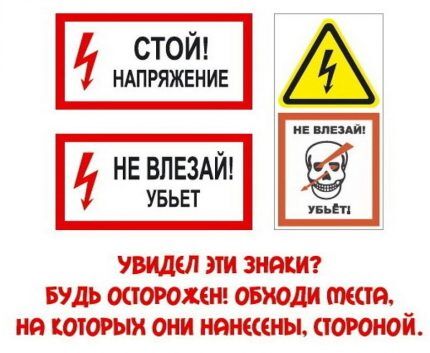
Sometimes they try to attract attention, partially using the rules for designing posters and adding something of their own:
Sometimes the signs are humorous. But the main thing is that they perform the main function - they warn or prohibit.

There are no prohibitions on the placement of posters made in loose or imprecise design. The principle “more is better” applies here, since we are talking about preserving the health and lives of people.
Conclusions and useful video on the topic
Options for posters and signs:
Application samples:
The use of protective equipment is a necessary requirement of TB, thanks to which people’s health is maintained and the risk of electric shock is eliminated. Bright posters placed in the right places make it possible to quickly understand what can and cannot be done, where exactly to work, and what exactly to do.
You should not neglect them, at least in order to preserve your own life.
Please write comments in the block below, ask questions, post photos on the topic of the article. Tell us about your experience using posters as safety tools. Share useful information that will be useful to site visitors.




It is useful to know all the signs and symbols, because they warn us of real danger. Unfortunately, in our country safety precautions are often neglected, which is why there are many accidents both at work and at home. Moreover, this applies not only to electrical safety, but also to other areas of our lives. But the signs are specially made simple and understandable, so that even the simplest person can understand the danger they warn about.
We specifically purchased directional posters for the dacha, since we ourselves forget where the cable and other important places are located. And I try to notice warning signs on the street so as not to get under tension myself. Responsibility for the presence of warning posters and stickers should rest with the Housing Office. Since forewarned is forearmed. Everyone knows this.